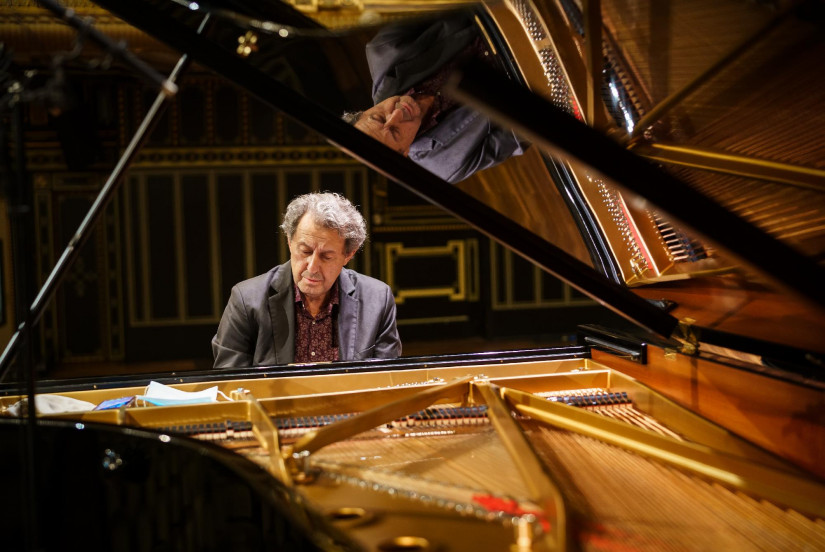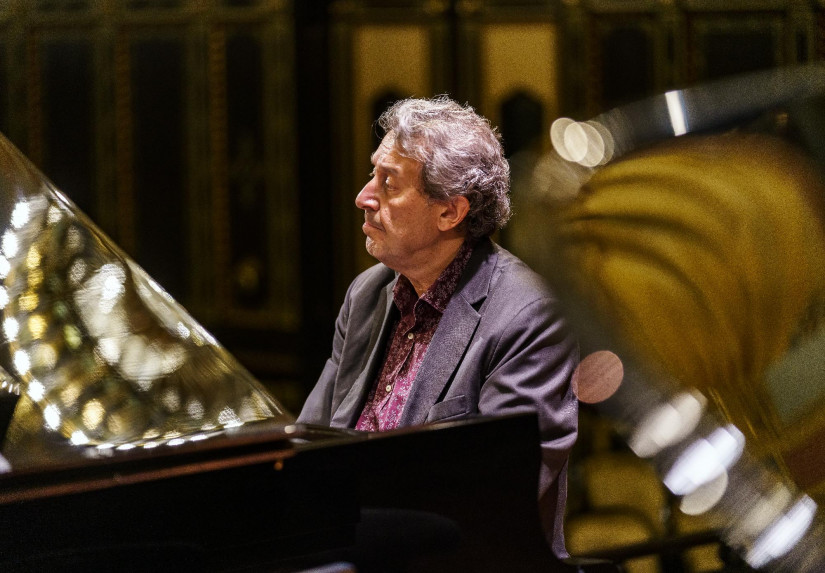“I’ve said good-bye to heading a department but not to teaching.”
A defining figure, a head of department who has just resigned his post, bade farewell in a special birthday concert. Kálmán Dráfi represents the oldest traditions of the Liszt Academy, the Liszt–Cziffra line, and has mentored a string of exceptional young musicians who are among the greatest stars on the Hungarian and international musical scenes. As a pianist, he still plays with the same intensity, elegance and emotionality as ever, something that makes him unique in the world today and has earned him success, competition awards and (now rare) concert recordings since his youth.
There was something special about this concert: didn’t it break your heart to see so few people in the concert hall, all wearing masks on top of it?
I was prepared, so I wasn’t disappointed. I’ve always played to full houses over the past 20 years, especially at the Liszt Academy: most recently, 100 people had to be turned away because all the seats were taken. But what can we do? It’s my 65th birthday, and most of my friends are either the same age as me or older. My musical career began very early. I was admitted to the Liszt Academy at the age of fourteen, so I was four to five years younger than my classmates. Many of those whom I’d invited to this concert told me over the phone that they wouldn’t be coming, that they couldn’t take the risk and that I shouldn’t be angry with them. Luckily, the turnout wasn’t as poor as to cause any embarrassment, and I was grateful to those who did attend and happy to play for them.
A lot has changed in the present situation: I haven’t been abroad for quite some time. I was to have travelled to Japan, where I’ve been teaching at five universities for over 20 years. Those courses have always been accompanied by concerts – but no concerts this time. Also, I should have gone to Iceland. That was cancelled too, and I’m sorry about that. I’ve just passed on the baton of leadership as head of the Keyboard and Harp Department – as there’s an age ceiling of 65 for that post – so now I’ve found enough time and energy to handle the enormous administrative workload. I’m glad it’s over.
 Photo: Liszt Academy/János Posztós
Photo: Liszt Academy/János Posztós
The programme is beautiful and light, at least for the audience. Wonderful and popular pieces: Chopin, Rachmaninoff, Love Dreams, Hungarian Dances.
Liszt, Chopin, Brahms, Debussy: that’s my world, and I admit it. I feel at home with other kinds of music, I teach modern, truly contemporary piano pieces, but they’re not me. A recitalist should be well aware of what best fits their personality, profile and artistic thinking. In selecting the programme, I had it in mind to play pieces that sum up my career and reflect the wonderful personalities to whom I’m indebted for all this.
The first piece, Funérailles – and György Cziffra. When I was recording my first Liszt record in Paris, I often went to see him in Senlis, and although Mihály Bächer, my teacher, had taught me to play Funérailles, Cziffra gave me a lot of wonderful instructions and showed me how to carry them out. Waltz in E flat major – it’s a piece I once won a competition with – and Magda Vásárhelyi, who taught me back in music school. The greatest teacher I have ever known, and what a pity we lost her so soon. I studied the Rachmaninoff pieces under Bella Davidovich in Moscow and learned Love Dreams from Cziffra as well. Then I played a single piece not linked to any of my teachers, but to an unforgettable experience: I’d heard Richter play Claire de lune here at the Liszt Academy. He played it like no one else before. So I tried to show the audience at least some small fraction of that, and I hope I managed to do so.
Just two years after you graduated from the Liszt Academy, you were teaching here. Were you invited?
Certainly, I was invited. I had plans to teach in Pécs. But when Dénes Kovács, the Rector at the time, and Professor Pál Kadosa heard about it, they asked me why I wasn’t going to start my teaching career right here. So I became assistant professor to Kadosa and Mihály Bächer, who sent me students to teach. At 19, I was thrilled by the situation: in the first five years, most of my students were older than me. But that was no problem, and anyway it soon passed: I’ve been teaching for 43 years, and I’m not going to quit. I’ve said good-bye to heading a department but not to teaching.
 Photo: Liszt Academy/János Posztós
Photo: Liszt Academy/János Posztós
How do you hold your lessons these days? Two pianos, social distancing, masks, constant disinfection – I don’t think you correct the fingering of your students by hand.
Indeed, I use my other piano to show what I have in mind. Keeping my distance is very important now. Luckily, the academic year has got off to a good start from our perspective, but the main subject is only being taught with the teacher and the student in the room. Earlier on, students would call in to see my classes and those of others: I’d be teaching one student, and the others would be sitting on chairs and listening to the analysis and learning from each other too. Now it has to be just the two of us. And I do hope we’ll carry on like this, as it would be much too difficult to transpose such a session for cyberspace. The piano certainly can’t go online as there’s no technology available to convey the sound of the piano. We’ve tried every option and application, but none was good enough for us to use. The piano has such a dense sound, with so many notes sounding at the same time and in succession – that’s all right for singing or playing the violin but not for playing the piano. I strike a chord, then another, and that’s it, we don’t hear a thing, it falls apart. We suffered a lot because of that at the end of the term.

A lot of successful concert pianists, such as the Kossuth Prize awarded János Balázs, whom you played together with at the concert, were once your students. How do you do it?
Training recitalists is only part of the mission of the university: it’s also important to train teachers and outstanding musicians who will do very well in orchestras and chamber formations. I, however, train recitalists from the first moment on because I think that’s what I’m best suited for. That explains my choice of students, and they choose me on the same grounds. In cases like that, tuition is based on a philosophy slightly different from that of other courses: beyond technical skills, style and musical talent, one needs an understanding of human nature and psychology. In my classes, we explore music to its core: I concentrate on the philosophy contained in the music rather than objective knowledge that can be written into the score or learned from books. The latter is very important, but it represents square one for the student, that is, nothing. At this point, you have to start working and add the extra bit that places Mozart above Salieri, and that’s what a good teacher can add, provided that the student is not only talented, but also receptive and sensitive enough to take it all in. Talent, however, is impossible to add, as György Cziffra used to tell me while I was his teaching assistant in Senlis. Talent is God-given, and it can’t be enhanced by the teacher, but it can quite easily be damaged. Here lies the teacher’s responsibility. If I had to define talent, I would say: sensibility and receptiveness. An old, experienced teacher comes along, who knows all about the job, and the student accepts everything because they believe in the teacher. But what happens if the teacher is labouring under a misapprehension, doesn’t see it right, has got it wrong, or is simply mistaken: it’s a tragedy because the student takes the wrong path. Another example: the teacher may put the student’s talent in a small box, make it square and stifle it, showing the limits rather than infinite freedom, thereby destroying that talent. Teachers all over the world often make the mistake of restricting students’ freedom; that is, they tell them what they must not do without telling them what to do instead. I myself used to have a teacher who kept telling me, this is too loud, that’s too fast, and so I played it more softly or more slowly and full of fear. Then he said, that’s right. What can you learn from that? Nothing.
Dohnányi employed a method which Bächer adopted: the students attended lessons together, listening to the teacher and one another. It was Liszt that established this method. His students also attended lessons together, but what mattered to him most was to put students under a master who was both a good teacher and a great musician. When he played something for them or showed something to them, there were no further questions or explanations. Bella Davidovich, whom I mentioned before, was one of the world’s greatest Chopin recitalists, and I attended her course in Moscow. She’s very old now and stopped giving concerts a long time ago, but she was magnificent: she would sit down at the piano, and I knew at that moment what it was all about. But that’s the only way it can be. How can you teach talents when you’re not up to their level?
By the way, it’s not exactly true that I only teach recitalists: teacher training is at least as important, and I also have students who I know will make excellent teachers. Everyone has their own path. Being a good teacher also means discovering a student’s potential, their strengths and weaknesses. You mustn’t overshoot your goal. But if your goal is the infinite, then it shouldn’t be curbed.
Ágnes Mester


